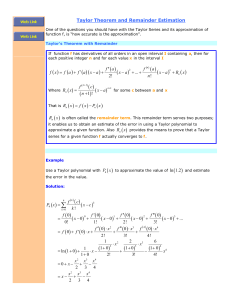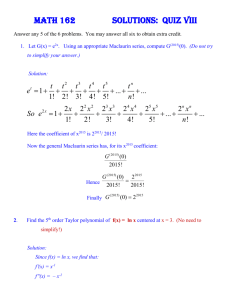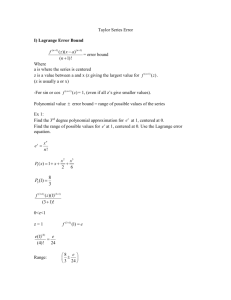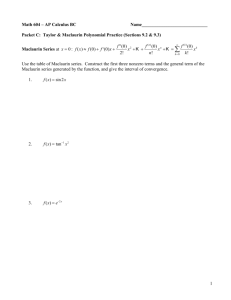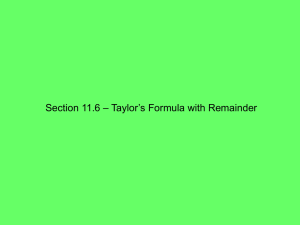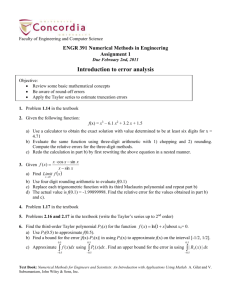Mathematics 120 Solutions for HWK 25a
advertisement
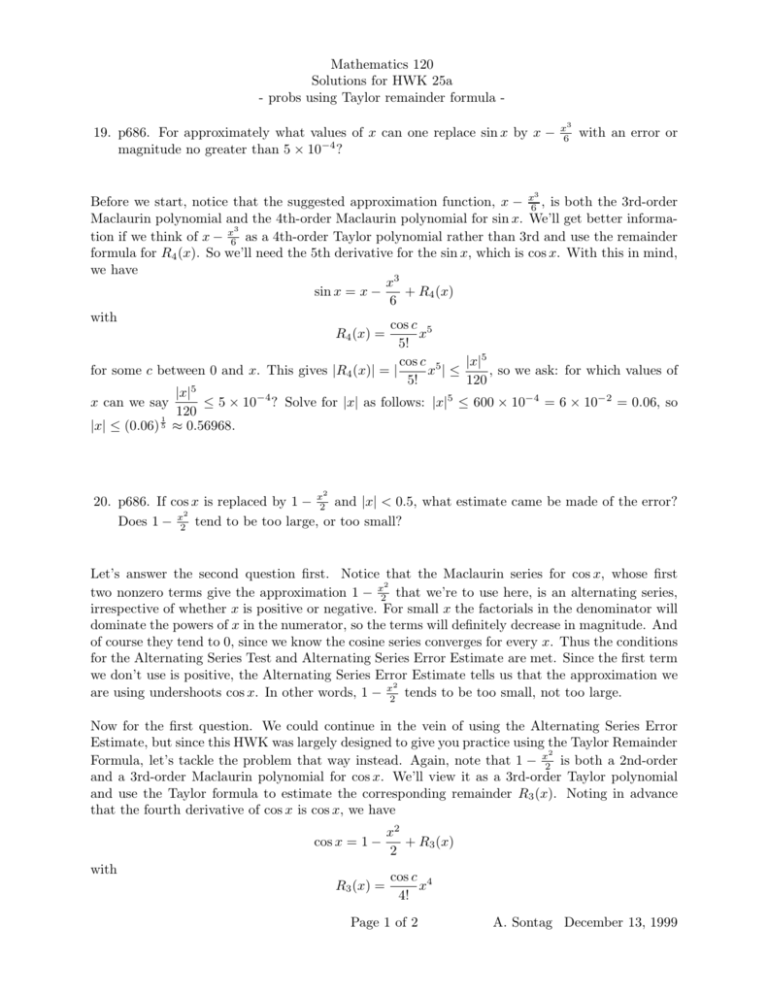
Mathematics 120 Solutions for HWK 25a - probs using Taylor remainder formula 19. p686. For approximately what values of x can one replace sin x by x − magnitude no greater than 5 × 10−4 ? x3 6 with an error or 3 Before we start, notice that the suggested approximation function, x − x6 , is both the 3rd-order Maclaurin polynomial and the 4th-order Maclaurin polynomial for sin x. We’ll get better informa3 tion if we think of x − x6 as a 4th-order Taylor polynomial rather than 3rd and use the remainder formula for R4 (x). So we’ll need the 5th derivative for the sin x, which is cos x. With this in mind, we have x3 sin x = x − + R4 (x) 6 with cos c 5 R4 (x) = x 5! cos c 5 |x|5 for some c between 0 and x. This gives |R4 (x)| = | x |≤ , so we ask: for which values of 5! 120 |x|5 x can we say ≤ 5 × 10−4 ? Solve for |x| as follows: |x|5 ≤ 600 × 10−4 = 6 × 10−2 = 0.06, so 120 1 |x| ≤ (0.06) 5 ≈ 0.56968. 2 20. p686. If cos x is replaced by 1 − x2 and |x| < 0.5, what estimate came be made of the error? 2 Does 1 − x2 tend to be too large, or too small? Let’s answer the second question first. Notice that the Maclaurin series for cos x, whose first 2 two nonzero terms give the approximation 1 − x2 that we’re to use here, is an alternating series, irrespective of whether x is positive or negative. For small x the factorials in the denominator will dominate the powers of x in the numerator, so the terms will definitely decrease in magnitude. And of course they tend to 0, since we know the cosine series converges for every x. Thus the conditions for the Alternating Series Test and Alternating Series Error Estimate are met. Since the first term we don’t use is positive, the Alternating Series Error Estimate tells us that the approximation we 2 are using undershoots cos x. In other words, 1 − x2 tends to be too small, not too large. Now for the first question. We could continue in the vein of using the Alternating Series Error Estimate, but since this HWK was largely designed to give you practice using the Taylor Remainder 2 Formula, let’s tackle the problem that way instead. Again, note that 1 − x2 is both a 2nd-order and a 3rd-order Maclaurin polynomial for cos x. We’ll view it as a 3rd-order Taylor polynomial and use the Taylor formula to estimate the corresponding remainder R3 (x). Noting in advance that the fourth derivative of cos x is cos x, we have cos x = 1 − with R3 (x) = x2 + R3 (x) 2 cos c 4 x 4! Page 1 of 2 A. Sontag December 13, 1999 Math 120 HWK 25a solns continued 1 for some c between 0 and x. Since | cos c| ≤ 1 and |x| < 0.5, this gives |R3 (x)| ≤ (0.5)4 = 24 1 1 = ≈ 0.002604167. 24 · 16 384 x2 is used when x is small. Use the Remainder 2 Estimation Theorem to estimate the error when |x| < 0.1. 23. p686. The approximation ex = 1 + x + What the text calls the Remainder Estimation Theorem is a consequence of the Taylor Remainder Formula that we’ve been using. It’s pretty straightforward, but we didn’t actually discuss it, so let me change the instructions on this problem slightly. Instead of ”use the Remainder Estimation Theorem”, let the problem read ”use the Taylor Remainder Formula” to estimate etc. We recognize the specified approximation as the 2nd-order Maclaurin polynomial for ex . So we want to get an upper bound for R3 (x) given that |x| < 0.1. The derivative we need is just ex . We have x2 ex = 1 + x + + R3 (x) 2 with R3 (x) = ec 3 x 3! for some c between 0 and x. For |x| < 0.1, the largest value of ec will occur when x = 0.1, and 1.1052 this largest value is e0.1 ≈ 1.105171. Therefore, for |x| < 0.1, we have R3 (x)| ≤ (0.1)3 ≈ 6 .000184195 ≈ 1.84 × 10−4 . (The final answer in the text appears to be off by a decimal place, although the intermediate result is correct. Also, the text used a calulator value for 30.1 instead of a calculator value for e0.1 as an upper bound for the numerator ec . Either one is correct, but ours gives a slightly tighter estimate.) Page 2 of 2 A. Sontag December 13, 1999
